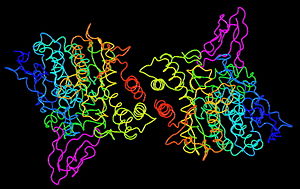Sandbox 251
From Proteopedia
| |||||||||
| 1fss, resolution 3.00Å () | |||||||||
|---|---|---|---|---|---|---|---|---|---|
| Ligands: | , | ||||||||
| Activity: | Acetylcholinesterase, with EC number 3.1.1.7 | ||||||||
| |||||||||
| |||||||||
| Resources: | FirstGlance, OCA, RCSB, PDBsum | ||||||||
| Coordinates: | save as pdb, mmCIF, xml | ||||||||
ACETYLCHOLINESTERASE (E.C. 3.1.1.7) COMPLEXED WITH FASCICULIN-II
Overview
BACKGROUND: Fasciculin (FAS), a 61-residue polypeptide purified from mamba, venom, is a three-fingered toxin which is a powerful reversible inhibitor, of acetylcholinesterase (AChE). Solution of the three-dimensional, structure of the AChE/FAS complex would provide the first structure of a, three-fingered toxin complexed with its target. RESULTS: The structure of, a complex between Torpedo californica AChE and fasciculin-II (FAS-II), from the venom of the green mamba (Dendroaspis angusticeps) was solved by, molecular replacement techniques, and refined at 3.0 A resolution to an, R-factor of 0.231. The structure reveals a stoichiometric complex with one, FAS molecule bound to each AChE subunit. The AChE and FAS conformations in, the complex are very similar to those in their isolated structures. FAS is, bound at the 'peripheral' anionic site of AChE, sealing the narrow gorge, leading to the active site, with the dipole moments of the two molecules, roughly aligned. The high affinity of FAS for AChE is due to a remarkable, surface complementarity, involving a large contact area (approximately, 2000 A2) and many residues either unique to FAS or rare in other, three-fingered toxins. The first loop, or finger, of FAS reaches down the, outer surface of the thin aspect of the gorge. The second loop inserts, into the gorge, with an unusual stacking interaction between Met33 in FAS, and Trp279 in AChE. The third loop points away from the gorge, but the, C-terminal residue makes contact with the enzyme. CONCLUSIONS: Two, conserved aromatic residues in the AChE peripheral anionic site make, important contacts with FAS. The absence of these residues from chicken, and insect AChEs and from butyrylcholinesterase explains the very large, reduction in the affinity of these enzymes for FAS. Several basic residues, in FAS make important contacts with AChE. The complementarity between FAS, and AChE is unusual, inasmuch as it involves a number of charged residues, but lacks any intermolecular salt linkages.
About this Structure
1FSS is a Protein complex structure of sequences from Dendroaspis angusticeps and Torpedo californica with NAG and ZN as ligands. Active as Acetylcholinesterase, with EC number 3.1.1.7 Full crystallographic information is available from OCA.
Reference
Crystal structure of an acetylcholinesterase-fasciculin complex: interaction of a three-fingered toxin from snake venom with its target., Harel M, Kleywegt GJ, Ravelli RB, Silman I, Sussman JL, Structure. 1995 Dec 15;3(12):1355-66. PMID:8747462
Page seeded by OCA on Thu Nov 8 12:40:06 2007


